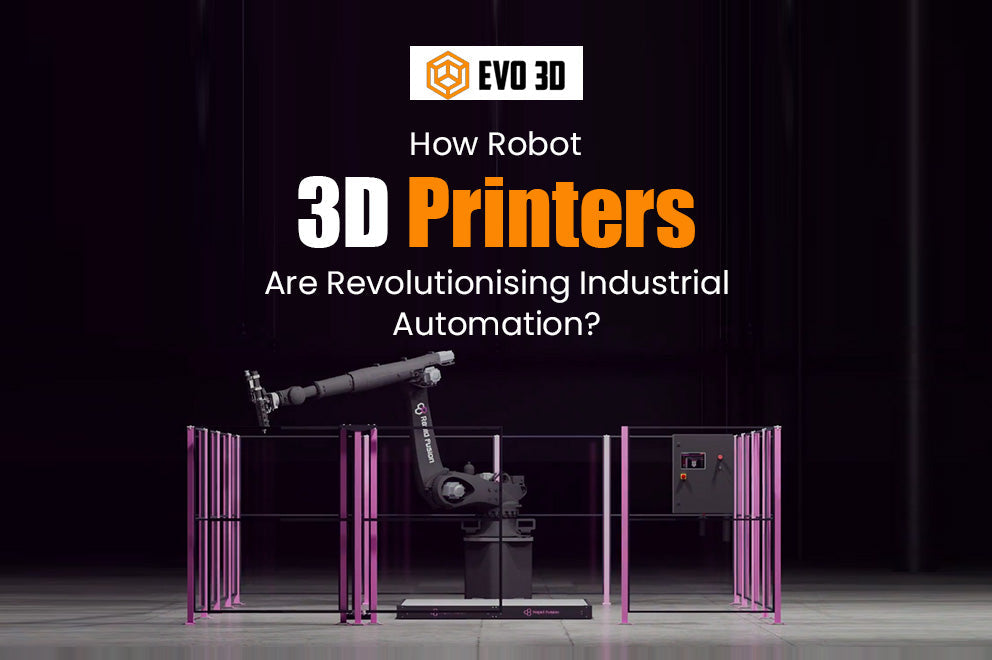How Robot 3D Printers Are Revolutionising Industrial Automation?

Gone are the days when every printing was done from traditional processes. With the start of automation, 3D printing has undergone a complete transformation, both in speed and capability. Now, we can see the exciting fusion of robotics and additive manufacturing in the form of robot 3D printers.
Picture a robotic arm, precisely controlled, building complex structures layer by layer without any error and great efficiency. This is not science fiction anymore; it's happening right now across industries. From automotive to aerospace, businesses are using robot 3D printers to reduce manual labour and accelerate production timelines.
Well-known providers like HP are all developing robotic 3D printing solutions that are helping manufacturers reshape how things are built. At Evo3D, by leveraging robotics, they’re bringing unmatched speed and reliability to production processes across various sectors.
What makes this change so fascinating is that it's empowering people and not replacing them. Engineers and designers can now focus on creativity and problem-solving, leaving repetitive tasks to smart machines. It’s not just a shift in tools, it’s a shift in mindset, and it’s redefining what’s possible in manufacturing.
In what ways do Robot 3D printers transform Industrial automation?
We see that industries are no longer bound by the limitations caused by traditional manufacturing. It is where robot 3D printers come into the picture. They combine precision, speed, and flexibility, all in one system. However, it goes beyond the technology; it's about how it changes the way people work.
The tasks that used to take hours or days can be completed in a fraction of the time. Engineers and designers are no longer stuck repeating the same motions; instead, they can focus on creativity, design, and innovation. It's not about replacing humans, it's about empowering them with smarter tools.
Now, engineers can prototype faster. Production lines become more agile. And businesses, both large and small, are starting to dream bigger, knowing that robotic 3D printing gives them the freedom to build what once felt impossible.
Increased Production speed
Have you ever wondered how robot 3D printers improve output times? Yes, robot 3D printers can work continuously with accuracy and around the clock, as compared to traditional systems that rely on fixed machines. They can automate manual and repetitive tasks that took days and can now be completed within a few hours.
Robotic arms are usually integrated with 3D printing heads, which allow for faster setups and smooth production flow. This isn't just an upgrade, it's a leap forward in efficiency. Manufacturers across industries are turning to robot 3D printers to meet tight deadlines without compromising on quality. As a result, you get faster prototyping, quicker production runs, and a significant competitive edge in the market.
Greater Design Flexibility
It is a well-known fact that traditional manufacturing limits creativity because of complex tooling and material constraints. However, a 3D printer, when combined with robotics, reduces these barriers. Engineers can design complex custom shapes without any additional tools or rework.
This freedom allows companies to test new ideas quickly and adapt products faster than ever. Whether it’s a single prototype or a custom part, 3D printers and robotics technology allow on-the-fly modifications, perfect for industries where innovation is constant. They also reduces waste by printing only what’s needed, making it both flexible and efficient.
Reduced Human Error
How can a large build volume 3D printer reduce the risk of production errors? Yes, absolutely, when large-scale projects are printed manually or through complex machinery, human error becomes a real concern. However, with a large build volume 3D printer combined with robotics, you get accurate 3D models.
These printers make use of advanced software and sensors to make sure that every layer is printed precisely, minimising mistakes and material waste. For industrial-scale production, fewer errors mean lower costs and higher-quality outputs. This level of consistency allows businesses to trust the process, especially when producing mission-critical components. With a large build volume 3D printer when integrated with robotics, precision is no longer an aspiration; it’s the standard.
Low labour cost
Did you know that robot 3D printers help reduce dependency on manual labour? Yes, it can help cut down overall production costs. Once programmed, they can operate with less supervision, allowing businesses to relocate their workforce to more strategic and creative tasks.
This not only improves efficiency but also increases team productivity, where they no longer need to perform repetitive or physically demanding tasks. Over time, using these robot 3D printers can significantly lower labour expenses, especially for businesses scaling up production. It’s a smart investment for companies aiming to stay competitive in an automation-driven market.
Robot 3D Printers Are the Future—Bring Them into Your Workflow.
To conclude, robot 3D printers are not just a technological upgrade; they are a transformative force in industrial automation. They combine speed, flexibility, precision, and efficiency into a single, intelligent system. They are going to rule the printing industry due to being automated and robotic.
Global players like HP are making robotic 3D printing more accessible, allowing businesses to choose from a range of solutions that best fit their workflow and scale.
At Evo3D, we provide advanced robotic 3D printing solutions designed to meet the needs of modern manufacturing. We help businesses integrate smart automation into their workflows — improving productivity and accelerating innovation. Connect with us to know more about printing solutions.
